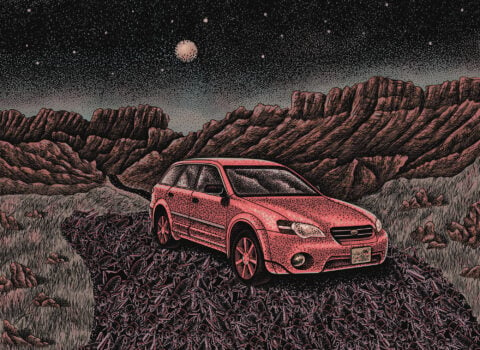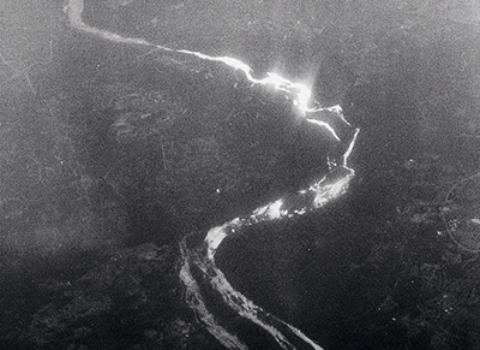It might be necessary to work backward
from tool marks and defects in the material
on which the sky is painted, inspect the hinges
joining the sky’s three panels, yet it might
also be necessary to work forward,
protecting what doesn’t exist from decay,
light effect by light effect. The placard says
perspective is reinvented in this picture,
those angels represent a revolution in
the depiction of angels, but the halos
don’t occupy real space, all they ever wanted,
I mean the sinners on whom God has rained,
rains fire. A conservator should be prepared
to work in rain or otherwise inclement
conditions, to work within an institution,
local at first, then distant, like his love,
if we’re going to revolt against conventions
governing how donors are depicted beside
angels, who mark the historical transitions.
The placard says things about provenance
I can’t follow, but “bequest” reminds me,
I’ve been meaning to bequeath an innovation,
a small innovation in a minor tradition
like this one, maybe the way I’m handling
portions of the right edge, where old light
streamed, is streaming. I’m here awaiting
test results, but know I don’t get service in
medieval wings, as if the paintings stopped
time, all they wanted from their medium,
even or especially when the medium was
time, as in music. Do you know music?
Composed and performed for many purposes,
popular all over the world, in the past it was
religious, and, while I didn’t know it then,
I heard some, hear it, whereas most people
alive today have only seen it. Here I am
mitering two dreams: the dream of the poem,
then the dream of the poem of that dream,
the one you write on waking, publish in
Lana Turner or The Paris Review, but
you can’t really join them, the dreams I mean,
not without their collapsing into prose, so
you write two novels, waiting for results
it might be necessary to work back from.
If I got service I could hear from an office
of one sort or another, the way Rilke heard
from the torso of Apollo, only this time
it’s a headless body with a bored voice
and you’ve returned to the Met to hide
from experience. On the backs of paintings
signs of experience are visible, conservators
date eternities. It’s an everyday thing,
if you’re a conservator, to restore a revelation
attributed to a disciple, then return it to storage:
the basements are full of virgins alarmed
by a sudden vision, as if Gabriel had brought
test results. And he has: you’re pregnant.
But I’m a virgin! But I’m a boy! I don’t
exist! Doesn’t matter: they can work forward,
they can depict your crucifixion on the right
while on the left you’re about to be born,
neither you nor anybody else within
the painting can know, unless you’re painted
by a master because a master can suggest
knowledge in a halo. You can’t see
your own halo, it hails from the future,
scary to realize you’re looking out from
a painting, that you’ll crack if you blink
and yet I’m afraid that’s why I’m calling.

Mother and Child, by Pablo Picasso © ARS, New York City/RMN-Grand Palais/Art Resource, New York City
A lot of theoretical issues surround conserving
work made out of organic substances: fat,
vegetable matter, blood and feces, dust,
toenail parings, chocolate, and the true
form of a work might be to flake, rot,
or otherwise register time, the way
I accidentally praised passages of water
damage when I visited a studio after Sandy
or the dream I had about being in the room
when the plug was pulled on Oldenburg’s
Ice Bag–Scale C, a kinetic sculpture
difficult to restore but easy to replicate,
a mode of destruction. The time is coming
when the doctor enters the room and says
we can’t restore you, but here’s a pamphlet
explaining replication and its pricing, or
that time has passed, I haven’t kept up
since Lucía was born, and now we are
expecting another, not another Lucía,
another girl, the due date is late June,
a scheduled C for a number of reasons
Ari wouldn’t want me to put in a poem
even though she knows that poems are great
places to make information disappear,
dissolve. Should it bother me that Schedule
C is the name of a tax form on which you list
income and expenses related to your self-
employment and is used by sole proprietors,
which I am, at least since I wrote novels,
write them? Of course it should: a curtain
divides her while they work, I can’t not think
of how magicians — men — saw women
in half and yet conserve them. A fine line,
only minimal scarring, between restoring
an everyday object and making a new one,
and now many artists are designing works
they require future technology to realize,
like 4-D printers, so what’s conserved is virtual:
that’s how I think of both poems and novels,
the main difference is in deductions, how
and how much you withhold from the actual
and for how long. Is Oldenburg dead?
Google says no, he’s eighty-six at the time
of writing, but you should probably check
at the time of reading, because whether we
should involve the artist, consult his intentions,
is just one of the issues surrounding work
that takes up space and/or exists in time,
subject to taxation. I don’t get service
in Mt. Sinai, I remember from Lucía’s birth,
I’ll have to step back into the world to post
or receive results, funny how you can’t
get calls from the institution when you’re in it.
Here is a pamphlet about cord-blood banking:
I can’t follow what it says about provenance.
The artist desired a medium that could bind
colored particles to themselves and the support
without suppressing vibrancy as they dried,
a version of the oldest desire: to arrive
at identity through dissolution, absinthe
poured over sugar. It could have worked
for a while, but the problem is that blue,
of all the colors, is the most historical:
a blue can change its meaning in an hour
lasting years, my definition of an epoch,
not that I’ll be consulted about our own
transition. Those suggestive shadows
we admired for centuries turned out to be
a consequence of candle smoke and glue
varnish, so said the restorers who developed
aggressive solvents used to remove
what they supposed were alien substances.
Now we’re told the new tonal modeling
destroyed the sculptural effects we had been
right to feel dissolved by in the first place:
an expansive fold of drapery that hangs
from the lower left leg no longer sweeps
down gracefully from below the knee,
emerging abruptly at the shin instead,
a minor crime, but against humanity.
A blue that changed patterns of thinking
if not patterns of thought, for a generation
of religious scholars has obtained, is
obtaining over Brooklyn as I write this,
the first poem that mentions my daughter
by name, unless it becomes a novel.
If it does, rinse away the efflorescent salts
to reveal a poem of inaccurate vividness
I’ve composed without my knowledge
the way some people sleep-drive on Ambien,
America’s number-one-prescribed hypnotic.
The blue of pills, the blue of links, the two
blue lines that indicate you’re pregnant,
lapis lazuli mined in Afghanistan
then crushed to depict a donor’s garment:
none of these would have appeared as blue
to the ancients, who couldn’t see the color,
or so says a team of researchers at MIT
as you’ve probably read on the Internet.
If that’s true, we can’t restore ancient art
without delicate optical surgeries
insurance won’t cover, which means
only the wealthy will be able to afford
classical blindness. We could manage
for Lucía, but not for two kids, at least
not in Brooklyn, unless I move toward
genre fiction: strange to think the future
of the past depends on vampire sagas, soft
porn, First World problems, false spring
poems about death and taxes. Better to be
replicated than restored from the wrong
settings, world, or period, but it’s best
to be printed layer by layer in a granular
bed, sintered by laser, or left unrealized.
Where were you when you realized the white
marble statues had once been painted
garish colors, that the Parthenon looked
like a miniature-golf course in Topeka?
I was in the Roman Sculpture Court, avoiding
results among enucleated heroes, furies
a few hours ago, and thought I would
have preferred to have heard that news
from a poem, not an audio guide or placard.
Somebody should inform the eighteenth century
they are basing their revival on projected
shadows, just as someone should tell Homer
the sea is a color between violet and green
we could restore to his sight with lasers.
The problem is how to deliver the news
in a form that dissolves it into feeling
faces can be imbued with, and for conservation
purposes, the sky is the face of a period.
Today I agreed to donate all my organs
except heart valves, although it’s corneas
I’d like to pass on to the future, not because
I’m so great at focusing or refracting light,
but just because I’d like to be the medium
waves enter en route to sentiment, plus
a donor poses an interesting formal challenge
since the painter must depict him both beside
the angel and a world apart, their bodies
subject to different laws, although the word
“angel” can mean donor now, confusing
exchangeability with translucence. At first
they were depicted on a smaller scale
than principal figures, compromising
linear perspective, so eventually they were
integrated into the scene but not allowed
to touch anything, although a Madonna
might glance down benevolently at a banker
kneeling forever in the foreground. Forever
is not eternity: forever takes place in time,
whereas eternity transforms large domes
into upwardly spiraling vortices of clouds,
dissolving the ceiling, restoring it to God
who sees the future like we see the past:
painted, which must be confusing since
the future is digital, as the poster says
at the DMV, where I don’t get service, a future
without lines. According to Wikipedia,
before the fifteenth century a physical likeness
may not have been attempted or achieved,
only later were the donors portrayed
carefully, as historical persons instead of as
whatever the opposite of a historical person is,
an angel? Homer? “Daughters in particular
appear as standardized beauties in the style
of the day,” says no one in particular on a page
anyone can edit or restore. She has my eyes.
We didn’t name her for the patron saint
of the blind whose remains were stolen from
Syracuse, part of why they commissioned
Caravaggio, who’d just escaped from prison,
to depict her burial, we named her for
light itself, though neither names nor light
behaves that way in time. You can exchange,
the commission implies, bodies and paintings,
doing time for depicting it, suspend
sentences across lines, but you can’t control
donations, your tissues could end up
supporting a face you don’t believe in.
People can get paid to give sperm or eggs,
blood or plasma, but it’s illegal to sell
organs, otherwise the rich would commission
the unincarcerated poor, whereas now
the rich will commission anyone, even
servants, disciples, assistants, who are often
tasked with underpainting sky, rarely
charged with depicting impregnation
through actual light or the virtual music
we can’t play in time, its instruments
still to be invented, and yet you still
hear it “in the future as in the past,”
a stillness streaming live across
margins, media. Too late to restore it and
too early, but it’s always being conserved
imperfectly for the future in a poem
read forward and backward at once
inaudibly. An X-ray will discover
a hidden portrait or overturn an attribution
in my body, or the radiograph will reveal
no pentimenti, which would suggest I am
a copy, either way I’m calling now
from outside the institutions, broken
speakers beneath a weeping cherry
just off Flatbush, the cardinal’s string
of down-slurred whistles, hammering in
the middle distance, police choppers.
That they can hover above the open-air
performance, but can’t enter the invisible
theater, indicates that spring is a massive
rally against the law, the actual play
beside the point, the actors mainly kids
from the neighborhood, tinsel-wrapped
pipe-cleaner halos. The youngest players
keep wandering back into history where,
swooped up by a guardian, they are restored
to the chorus, then wander off again:
I’ve read the polemics against the figure
of the child, agree the available futures
they are made to represent must be dissolved,
agree it’s not even my place to agree,
I largely belong to the order marked
for destruction when the revolution
in perspective is achieved, but the love
I work within is not genetic, even if organic
substances are used, the smell of micro-
flora blooming in the soil when it’s turned,
is turning. Spring is a massive rally
creeping backward into the year, so it
gets later early now, rally against the test
results and recommended measures, serial
echoes, periodic scans. Its parapet exists
to connect the fictive world of the sacred
with the temporal one in which we view it,
more effective is how the bottom edge
of spring is burned in places: do you sense
how the artist worked from photographs
untaken at the time, that affect here awaits
experience in form, like color in a color
word, or like a given name you less
grow into than are trained around? Yes
and no, forward and back, chain-link fence
with wine-dark blossoms I have to keep
Lucía from eating, no, they’re fine to eat,
just googled it. My sorrowful expression
reveals no foreknowledge, let alone about
what’s happening in a panel to my left,
the viewer’s right, “he’s just a donor,”
like everybody else, my features general
as money when at rest. It’s raining now
it isn’t, or it’s raining in the near
future perfect when the poem is finished
or continuous, will have been completed
when we figure out how rain can be depicted
without a lens or window since all this
takes place when glass was rare and rain
was sometimes fire, although it’s warm
enough to let her play in for a while now
it stopped. In the future there were tenses
to express what it’s like to be alive today
so we won’t need names, but for the present,
even though the root is war, I like Marcela,
Chela to her friends, and a friend of my
daughters’ is how I think of you, reading
a poem you’re on both sides of like a court
painter during a historical transition,
the restoration spring always almost is.


































































































